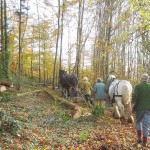Hallr Wood – information about the wood
Hallr Wood is privately owned and managed sustainably for wildlife and conservation by groups and volunteers. When CSOLP became involved (2007), it had been neglected for many years. We have been thinning rabbit damaged trees and restocking windblown areas with native broadleaves in order to improve biodiversity. On April 13th 2011 South Somerset Area East Planning Committee unanimously agreed to grant us change of use to mixed forestry and educational use. We now have some on site parking and continue to have access to Charlton Mackrell Parish Car park.
The woodland is divided into several sections; predominantly ash and norwegian maple in the flatter area with two beech areas and a more mixed area to the east and also an area of larch, some of which has proved good enough to get planked for projects. Although mostly planted in the early 1960’s, there are several mature specimens; field maples, spindles, cherrys, horsechestnuts, lime and walnut.
We have a path which goes around the wood so that the central portion can remain mostly undisturbed for wildlife. There are foxes, hares, rabbits, an extensive colony of badgers and some very cheeky squirrels who have taken up residence in some of our nesting boxes. Deer are also a hazard to our newly planted trees. Birdlife is abundant. We frequently see and hear wrens, jays, green woodpeckers, nuthatch, warblers, mistlethrush, ravens, great tits and blue tits, chiff- chaff. We have several very friendly robins who feed from our hands during cold spells. Birds of prey are varied and plentiful; we have been lucky enough to see a pair of peregrine falcons which we think were nesting up on Green Down. After dark we hear tawny owls, little owls and we often see a barn owl hunting across the fields towards the nearby River Cary. In 2012 we heard nightingales in May.
Our manangement plan includes creating glades and more middle storey planting. We have been planting native broadleaves and also increasing amenity value by planting woodland bulbs and primroses. We have set aside our dragon (which forms a bank segregating the car area from the rest of the wood) as a butterfly and bee friendly area. Our restored pond has also improved habitat value and many of the nest boxes are used.
The wood is used by many groups although we monitor use to safeguard the site and ensure it isn’t over used. The bulk of our activities are focused around improving the biodiversity of the site and conservation and we actively engage secondary pupils in this as part of their alternative curriculum.

